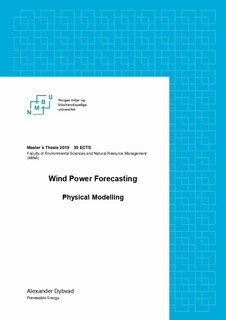| dc.contributor.advisor | Gravdahl, Arne | |
| dc.contributor.author | Dybvad, Alexander Stokke | |
| dc.coverage.spatial | Norway | nb_NO |
| dc.date.accessioned | 2019-08-16T09:05:47Z | |
| dc.date.available | 2019-08-16T09:05:47Z | |
| dc.date.issued | 2019 | |
| dc.identifier.uri | http://hdl.handle.net/11250/2608659 | |
| dc.description.abstract | With the stochastic nature of wind power and the increased penetration of wind power in the energy system, new challenges become eminent. For the Transmission System Operators (TSOs), the increased penetration of wind power in the energy system makes the task of balancing the energy system more demanding. With the challenge of recreating actual wind conditions at the wind farms, physical modelling is becoming a preferred method. It has proven to increase the accuracy in wind power predictions. The use of computational fluid dynamics (CFD) has shown to be especially beneficial in complex terrain. To reduce the uncertainties in the wind power predictions, this thesis seeks to analyse the benefits of using CFD in wind power forecasting. With the work of analysing the potential benefits, two forecasting methods are tested. The first method uses an equivalent power curve and forecasted wind speed data from the weather service provider Yr. The second method combines the CFD program WindSim together with the forecasted wind speed data from Yr. The two forecasting methods are tested at the following wind farm locations in Norway: Bessakerfjellet, Hitra, Smøla, Valsneset and Ytre Vikna. The physical and CFD method performed the best in three out of the five cases analysed. In the case of Bessakerfjellet, Hitra and Valsneset, the use of CFD produced forecast with prediction errors of 16.56%, 16.64%, 15.58%, measured in normalized mean absolute error (NMAE). At Smøla and Ytre Vikna, the equivalent power curve obtained a prediction error of 13.21%, 20.69%. The findings indicate that the use of CFD and WindSim can contribute to more accurate wind power prediction. | nb_NO |
| dc.description.abstract | Med vindens stokastiske natur og den økte andelen av vindkraft i energisystemet, medfører dette nye utfordringer. For Statnett som transmisjonssystemoperatør (TSO), medfører den økte andelen av vindkraft at oppgaven med å balansere energisystemet blir mer krevende. Det å gjenskape og estimere faktiske vindforhold i en vindpark er en utfordrende oppgave. Fysisk modellering eller numerisk modellering (CFD) er blitt en av de foretrukne metodene for å kunne beskrive vindens bevegelse. CFD har også vist seg å kunne bidra til økt presisjon, og i vindparker med komplekst terreng har resultatene vist seg å være spesielt gode. For å redusere usikkerhetene i vindkraftforutsetningene, søker denne oppgaven å analysere fordelene ved å bruke CFD i vindkraftprognoser. For å kunne analysere de potensielle fordelene, testes to prognosemetoder. Den første metoden bruker turbinens ekvivalente effektkurve sammen med vindhastighetsdata fra værvarslingstjenesten Yr. Den andre metoden kombinerer CFD-programmet WindSim med værvarslet fra Yr. De to prognosemetodene har blitt testet på følgende vindparker i Norge: Bessakerfjellet, Hitra, Smøla, Valsneset og Ytre Vikna. CFD- baserte metoden gjorde det best i tre av de fem analyserte vindparkene. For Bessakerfjellet, Hitra og Valsneset produserte CFD-metoden produksjonsestimater med en prediksjonsfeil på henholdsvis 16,56%, 16,64%, 15,58%, målt i normalisert gjennomsnittlig absolutt feil (NMAE). Ved Smøla og Ytre Vikna oppnådde metoden basert på turbinens ekvivalente produksjonskurve en prediksjonsfeil på henholdsvis 13,21%, 20,69%. Funnene fra analysene tyder på at kombinasjonen av CFD og WindSim kan bidra positivt til mer presise produksjonsestimater. | nb_NO |
| dc.language.iso | eng | nb_NO |
| dc.publisher | Norwegian University of Life Sciences, Ås | nb_NO |
| dc.rights | Attribution-NoDerivatives 4.0 Internasjonal | * |
| dc.rights.uri | http://creativecommons.org/licenses/by-nd/4.0/deed.no | * |
| dc.subject | CFD | nb_NO |
| dc.title | Wind power forecasting : physical modelling | nb_NO |
| dc.type | Master thesis | nb_NO |
| dc.description.version | submittedVersion | nb_NO |
| dc.subject.nsi | VDP::Matematikk og Naturvitenskap: 400 | nb_NO |
| dc.source.pagenumber | 68 | nb_NO |
| dc.description.localcode | M-FORNY | nb_NO |

